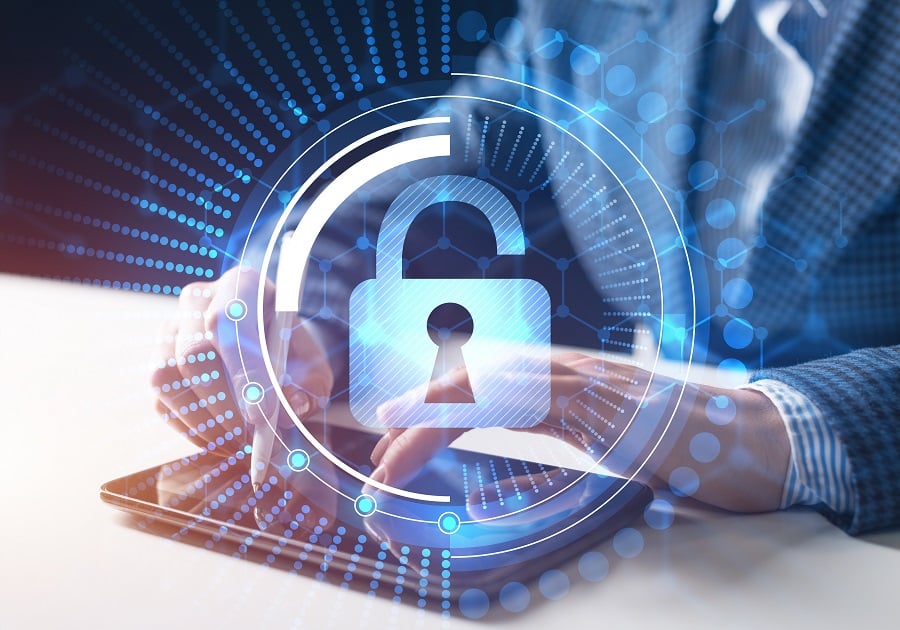Although cybersecurity is generally considered the sole responsibility of your organization’s security and IT departments, security is one of the most crucial components of keeping your entire organization’s operations running smoothly. Data breaches and other security issues can disrupt operations and damage an organization’s reputation.
The IBM Cyber Security Intelligence Index Report states that human error is a major contributing cause behind 95% of all breaches, indicating that the responsibility for maintaining a high level of security extends far beyond IT and cyber teams. Giving every department a role to play increases the general awareness of cybersecurity within your organization and grants you the extra protection of a human firewall created by your employee’s commitment to the organization’s security.
A human firewall is more than just a supplement to standard cybersecurity measures; it can even serve as its foundation. In this guide, we discuss:
- What a human firewall is
- Why you need a human firewall
- Why are employees the biggest cyber risk
- How to build a successful human firewall
- Essential resources to help you create an effective human firewall
- How to launch your human firewall
Keep reading to learn how you can give your employees the initiative and education to take control of your cybersecurity.

What is a human firewall?
A human firewall is a team of well-trained and motivated individuals from within your organization. They serve as the first line of defense protecting your organization against cyberattacks and can be crucial for its security strategy. The leading cause behind data breaches is human error, meaning that the need to create an effective human firewall is more urgent than ever before.
Most cyberattacks only succeed because the people within the organization lack the knowledge or expertise to recognize and avoid the attack. Data breaches are often caused by malicious actors who gain access to the system through social engineering attacks such as phishing.
Social engineering exploits human vulnerabilities by manipulating people into granting malicious actors or spyware access to their network and devices.
As these attacks grow increasingly innovative and sophisticated, organizations need to provide their teams with the tools necessary to recognize and respond to these attacks. Human firewalls offer your organization’s members an opportunity to get a structured and continuous cybersecurity education, empowering them to avoid outside threats that put your organization’s data at risk.
In addition, a human firewall fosters an environment of mutual trust in which everyone has a role to play in maintaining your organization’s security, turning security concerns into a shared responsibility.
Why is having a human firewall important?
The total average cost of a data breach has been estimated to reach up to $3.86 million. Your organization can potentially avoid these unnecessary expenses by implementing a human firewall. Training employees to understand the dangers of phishing, social engineering, and other cyberattacks can help prevent major losses.
While many organizations rely on regular firewalls and other software-based security, a human firewall is the best first line of defense. As most data breaches rely on human error and exploit human vulnerabilities to gain access, many data breaches can be prevented proactively with the right tools and training. In addition, your organization’s security relies on the cooperation of all its staff members and not just IT functions.

Why are humans the biggest cyber risk?
Whether intentionally or unintentionally, the members of your organization have the power to grant outsiders access to your network and data. Here are some of the ways your staff can put your organization’s cybersecurity at risk:
Falling victim to phishing attacks
Phishing attacks are a type of social engineering in which malicious actors pose as trusted people or entities to manipulate victims into opening messages, downloading attachments, clicking links, or performing other seemingly innocuous actions designed to give the malicious actor access to an organization’s network or information.
Phishing attacks are generally in the form of email messages but can be directed through any messaging app. Although awareness has increased over the past few years, phishing attacks have evolved and grown more convincing and sophisticated.
The most reliable solution to protect your organization against these attacks is continuous and consistent education and training. Teaching your staff to verify all messages and carefully examine suspicious-looking links or websites can help keep your organization safe from the most common social engineering tactic.
Losing company devices
While most organizations focus their security measures on software threats, hardware is just as critical. As more organizations choose to embrace the work-from-home model, entrusting your staff with company hardware comes with education and understanding of the risks involved.
Organization hardware often contains sensitive information or can grant users access to your network. The result of your hardware falling into the wrong hands could have catastrophic consequences for your organization.
Ensuring all hardware has up-to-date security software and operating systems is just the first step towards a solution. Staff education and awareness is the only sure way to ensure all your devices and the sensitive data they contain remain in the right hands.
Password sharing
Password sharing is unfortunately common within organizations. For example, staff will often share accounts or passwords with coworkers or reuse the same password for multiple work accounts.
Password sharing can present a significant risk to your organization’s security, with a reported 80% of hacking incidents achieved with the aid of weak or stolen passwords.
Shared passwords allow a hacker to access multiple parts of your network using just one password. In addition, unsafe password storage such as Google Docs or notes applications can also put your entire network at risk, transforming what could have been a minor data breach into a network-wide security crisis.
Not sharing passwords among colleagues and utilizing password management software can help your staff create and remember longer and more complex passwords and avoid compromising security by sharing them.
Accessing sensitive information in public
It’s common for employees to spend an hour working in a pleasant public environment such as a park or café. Unfortunately, this has become so common that many people can become unaware of their surroundings. Threat actors see this as an opportunity to shoulder surf or spy on people while they use a device such as a phone, computer, or ATM in public until they successfully gather personal information such as passwords and PINs.
Unlike phishing, shoulder surfing is generally not targeted and can happen randomly whenever a threat actor sees an opportunity. Malicious actors use the information they collect to pose as others, enact phishing scams, or steal victims’ identities. Defending yourself and your staff against a random attack can be more challenging, but taking the proper precautions can ensure no member of your organization falls victim to shoulder surfing.
Precautions include maintaining awareness when accessing personal information in a public space, using solutions such as privacy screens to cover devices and prevent bystanders from viewing the screen, and avoiding working in areas where people can easily view your device.
Lack of training or awareness
The biggest threat your employees can present to your organization is a lack of awareness or education around cybersecurity. For example, most social engineering scams require an unknowing victim to grant the malicious actor access to information or a network. Having staff unaware of the security threats your organization faces or how to avoid them puts your organization in an extremely vulnerable position.
Providing your staff with the education and tools to react and respond to cyber threats is the surest way of ensuring they are dealt with before they have the opportunity to impact your organization or its operations. In addition, making employees active members of your security strategy empowers them to take action and respond to threats, dividing the responsibility among all departments, and making security a core value of your organization.

How to build a successful human firewall strategy
A human firewall needs to be based on an encompassing and reliable strategy designed to engage all members of the firewall and address any potential threats. These steps can help you build a human firewall strategy that is effective and engaging and utilizes your staff’s skills as the first line of defense against cyber threats:
1. Get employees involved in cybersecurity
Getting your staff involved in cybersecurity transforms security from the responsibility of one or two departments to a core value of the organization as a whole. Employees can act as a key, allowing hackers into your network through cyberattacks such as phishing, but they can also act as the lock protecting your network from being accessed by outsiders.
While the process can be challenging, awareness training and other educational resources are essential to keeping all your employees involved and engaged in the security process. Tweaking your training curriculum to appeal to all sectors within your organization, whether divided by age, department, or interests, is critical to ensure that all employees are on board and on the same page. Additionally, making your training applicable to everyday situations keeps it engaging and practical.
2. Educate teams effectively
Keeping employees engaged doesn’t end with one training session. Cyberattack techniques continue to evolve and become more convincing and sophisticated. Therefore, education should be maintained regularly to ensure that employees remain updated and aware of the latest attack methods.
Keeping the education consistent and digestible keeps employees updated on the latest attack methods without becoming overwhelming and gives them a role in the organization’s security strategy.
Maintaining a solid program that offers employees routine educational events encourages employee participation in cybersecurity and ensures that involvement and contributions remain helpful and practical. Education can be customized to meet employee needs and take the form of passive lectures or more active cyberattack simulations. Training and education give staff the tools to manage potential threats and empower them to act on this knowledge.
3. Assess your employees
Continuing training without assessing its effect on your employees is unlikely to yield the desired results. Routinely checking employees’ progress in training and checking engagement with phishing simulations can help gauge the effectiveness of your training and allows you to assess where changes need to be made to increase effectiveness.
While checking click rates is an effective way of testing how much employees engage with stimulations, reviewing progress goes beyond engagement or participation.
Corporate cultural change can be a process that happens over time, so it’s essential to assess each employee as an individual, accounting for their skills and mindset as well as a learning curve. In addition, it’s essential to keep in mind that progress and gradual improvement must be judged, not just numbers or immediate results.
4. Give high-risk employees additional support
Every organization has at least one employee more likely to fall for a scam or click on a suspicious link. Identifying this employee during training may feel like an urgent task, but rushing the process can lead to cases of mistaken identity. Assessing employees isn’t just seeing who clicked on the most simulations through one test. It involves spreading out several tests over time and assessing all employee progress.
Having zero high-risk employees is not a reality, so ensure that those you do have are continually learning and making progress. Once you have identified how much progress they are making, you need to decide if your organization can afford that level of risk or if you need to tighten security in other areas.
5. Build a human firewall plan
A robust human firewall needs blueprints to succeed. Educating employees may help them avoid security breaches, but creating robust security policy plans that they can implement gives employees something concrete to do and allows them to take proactive steps to maintain the company’s security.
Security-related factors such as passwords, email security, and social media use should all be guided by curated and consistent company policies. Enforcing these policies ensures that the organization has a high level of security as a whole. In addition, making these policies clear and known to all employees allows you to hold them accountable for following them.

Resources for human firewall programs
When designing and constructing your human firewall, it’s crucial to have a reliable roster of resources to turn to. Each of the following resources provides valuable insight to help you design an effective human firewall and protect your organization’s assets.
- Essential steps for a successful human firewall
A human firewall is one of the most critical components in your security strategy and can prevent your data from becoming compromised. Ensuring your firewall is effective is critical to protecting your organization against cyberattacks. An effective human firewall can serve as a defense against data leaks, breaches, or other attacks and should utilize the skills of your current staff to do so.
Maintaining an effective firewall relies on:
- Creating a security-centered organizational mindset
- Providing employees with ongoing education and regular training
- Increasing security awareness
These are just a few of the ways you can build and maintain an effective firewall. To learn more, take a look at our 7 Steps to a Successful Human Firewall.
- Create a meaningful security awareness program
Keeping your employees engaged and motivated to play a part in your organization’s security requires creating a security awareness program that speaks to them without talking down. Training needs to be intensive but focused on ensuring it meets your organization’s needs. Some of the ways you can ensure your program is meaningful include:
- focusing on high-priority threats
- focusing on the organization’s needs
- maintaining regular and continuous training sessions
For more information and helpful tips, check out our 3 Tips for Kicking Off a Meaningful Security Awareness Program.
- Cover the right material in your cybersecurity awareness employee training program
Providing employees with training becomes ineffective if the training doesn’t cover the employee’s needs. Assess your employees, your organization’s needs, and your program regularly to ensure you’re meeting their requirements. There are several core techniques every program must follow to ensure it’s relevant and effective. These include:
- Taking a hands-on and practical learning approach
- Using predictive analytics to assess the effectiveness and optimize the training experience
- Use real-time feedback to engage participants
To learn more ways to keep your training program effective, take a look at our 7 Essentials for Every Cybersecurity Awareness Employee Training Program.
- Avoid these mistakes when training your employees
Keeping training both effective and engaging can be highly challenging, but failing in either respect puts the effectiveness of your entire firewall at risk. Since your human firewall relies on the participation and engagement of your employees, training is a critical point in gauging its effectiveness. When implementing your training plan, avoid these common mistakes:
- Using repetitive training methods
- Relying on textbooks
- Not providing feedback
Find out more about these common mistakes and how you can avoid them by reading our 4 Common Mistakes in Employee Security Awareness Training.
- Learn how to increase security awareness
Awareness is as vital to cybersecurity as firewalls or other software measures. Social engineering attacks such as phishing, shoulder surfing, and malware thrive on a lack of awareness. Failure to cultivate a security-aware culture in your organization leaves you vulnerable to threats. Here are a few ways you can increase security awareness in your organization.
- Maintain a high level of regulatory compliance
- Protect personal data and other information
- Regularly update your software and operating systems
For more tips on how to increase cybersecurity awareness within your organization, see our 13 Can’t-Miss Cybersecurity Awareness Tips.
Launch your human firewall program
Before launching your human firewall, make sure you’ve included these essential steps:
- Create a culture of security awareness within your organization
- Put ongoing education and training plans in place for employees
- Assess your organization’s needs and your employee’s skills
- Use data and feedback to optimize your training and education programs
- Regularly review your employee’s progress and security awareness levels
Remember that this ongoing process requires constant review and optimization to ensure the best results.
CybeReady makes data protection and security awareness training easy and effective for organizations. Find out more by getting in touch today.

















